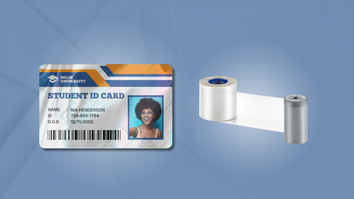Lamination is a critical feature in many ID card printers, adding an extra layer of protection that extends the lifespan of cards while guarding against fading, scratches, and everyday wear. For organizations issuing employee badges, student IDs, or secure access credentials, lamination is what ensures a card looks professional and remains functional over time.
But when the lamination process doesn’t go smoothly, the results can be frustrating and costly. If you’ve ever noticed bubbles, wrinkles, or peeling on laminated ID cards, the culprit is often tied to a few common printer-related issues. The good news? Most of them can be fixed with the right adjustments.
What Causes Lamination Bubbles and Peeling?
1. Card Surface Contamination
Dust, oil, or debris on a card can prevent the laminate from bonding correctly. Even small particles can cause bubbles or make sections of the laminate peel away.
Solution: Always handle blank cards by the edges and store them in a clean, dust-free environment. Use your ID card printer’s cleaning kit regularly to prevent residue from transferring onto cards during the print and lamination process.
2. Incorrect Heat or Pressure Settings
ID card printers with lamination modules rely on the proper balance of heat and pressure. If the settings are too low, the film won’t adhere. If they’re too high, the film can overheat, causing bubbles or warping.
Solution: Check your printer’s lamination settings and adjust them based on the card material (PVC, PET, or composite). Different card stocks may require different temperatures to laminate correctly.
3. Using Incompatible Supplies
Not every overlaminate film works with every ID card printer. Using the wrong laminate or generic supplies may cause poor adhesion, peeling edges, or surface bubbling.
Solution: Stick to genuine, manufacturer-approved laminates and ribbons designed for your printer model. This is especially important when laminating smart cards or cards with embedded technology.
4. Warped or Poor-Quality Cards
If cards aren’t perfectly flat or are made from lower-grade materials, the laminate won’t apply evenly. Heat from the printer can even exaggerate these flaws, causing peeling or separation.
Solution: Invest in ISO-compliant, high-quality cards and store them in a cool, dry place to prevent warping from humidity or temperature changes.
5. Worn Lamination Rollers or Misalignment
Like all machines, ID card printers require maintenance. Over time, rollers inside the lamination unit can wear down or become misaligned, leading to uneven pressure across the card surface.
Solution: Schedule regular servicing for your ID card printer. Preventive maintenance helps identify issues early, keeping large card runs from being wasted.
How to Prevent Lamination Issues in the Future
- Clean frequently: Use cleaning kits to remove dust and debris from the printer.
- Store supplies properly: Keep cards and laminates sealed in a cool, dry environment.
- Follow manufacturer guidelines: Use approved laminates and cards for your printer model.
- Run test cards: Before large print jobs, run a few cards to check for adhesion problems.
- Schedule maintenance: Routine servicing extends the life of your ID card printer and ensures consistent print quality.
Contact us today
When an ID card printer produces cards with bubbles, peeling, or wrinkles in the laminate, it’s more than a cosmetic flaw—it can reduce card durability and compromise built-in security features. Fortunately, most lamination problems stem from environmental factors, supply compatibility, or printer settings, all of which can be addressed with proper care.
By following best practices and using genuine printer supplies, your laminated ID cards will come out smooth, professional, and built to last. Contact us today if you have questions or need assistance.

